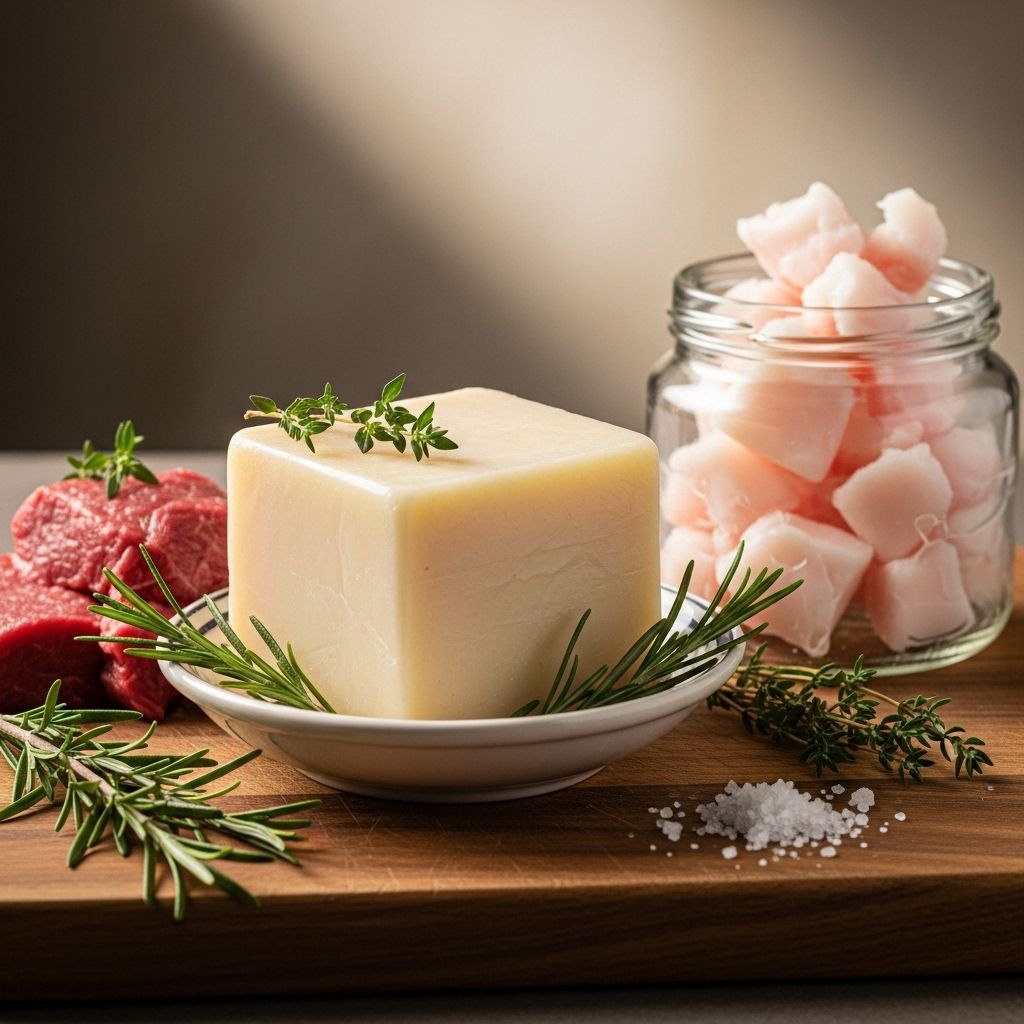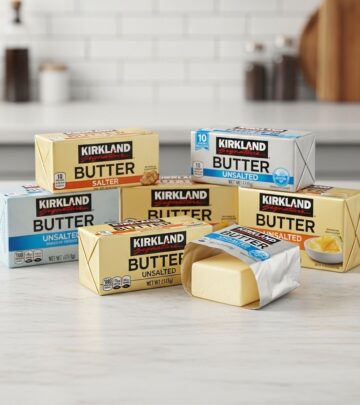Is Beef Tallow Healthy? Nutrition, Benefits, and Drawbacks Explained
Beef tallow is making a comeback, but is it truly a healthy choice? We explore its nutrition, benefits, drawbacks, and safe ways to use it today.

Is Beef Tallow Healthy? Nutrition, Benefits, and Risks
Beef tallow—once a pantry staple, now revived by new food trends—has sparked renewed debate among nutritionists, cooks, and health-conscious eaters. As this versatile animal fat reappears in kitchens and on social media feeds, questions abound: Is beef tallow actually healthy? How does it compare to other fats? What are its nutritional pros and cons? This article delves deep into the science, nutrition, and health implications of eating and cooking with beef tallow, evaluating expert opinions and current research to help you decide if it deserves a place in your diet.
What Is Beef Tallow?
Beef tallow is rendered fat from cows, usually made by slowly heating up beef fat trimmings (often called “suet”) until the pure fat separates and solidifies after cooling. With a waxy texture at room temperature and a subtle beefy flavor, tallow was historically popular for deep frying, roasting, and making pastry before vegetable oils took over in the 20th century.
Unlike modern seed oils, beef tallow is minimally processed (just rendered and strained), and its composition depends on cattle diet and how it’s prepared. Grass-fed tallow is often considered more nutrient-dense due to a higher content of omega-3 fatty acids and conjugated linoleic acid (CLA).
Key Characteristics of Beef Tallow
- Source: Rendered fat from beef, notably from the kidney and loin area.
- Texture: Solid at room temperature; melts when heated.
- Flavor: Mildly beefy, often neutral when properly rendered.
- Uses: Frying, sautéing, pie crusts, soapmaking, skincare balms, and candles.
- Color: Ranges from white to pale yellow depending on the cattle’s diet.
Nutritional Profile of Beef Tallow
Beef tallow is primarily composed of fat, with no carbohydrates or protein. The exact breakdown can vary slightly depending on the animal’s diet (grass-fed vs. grain-fed), but here’s a representative snapshot:
| Nutrient (per 1 tablespoon) | Amount |
|---|---|
| Calories | ~115 |
| Total Fat | 12.8 g |
| Saturated Fat | 6.4 g |
| Monounsaturated Fat | 5.4 g |
| Polyunsaturated Fat | 0.5 g |
| Cholesterol | ~12 mg |
| Protein, Carbs, Fiber, Sugar | 0 g |
Tallow is also a source of fat-soluble vitamins (especially A, D, E, and K) and other micronutrients such as choline and vitamin B12, especially from grass-fed sources.
Fatty Acid Breakdown
- Saturated Fats: 45–55%
- Monounsaturated Fats: 40–50%
- Polyunsaturated Fats: 3–7%
- Contains stearic acid (may benefit cholesterol levels), oleic acid, CLA (conjugated linoleic acid, with anti-inflammatory properties)
Health Benefits of Beef Tallow
Although beef tallow was once demonized during the low-fat diet craze, more recent research and expert reassessment are prompting some to reevaluate its role in a healthy diet. Here are the major proposed benefits of adding beef tallow to your meals:
1. Rich Source of Fat-Soluble Vitamins
Beef tallow provides vitamins A, D, E, and K. These are vital for vision, bone health, immune function, and antioxidant protection. Because these nutrients are fat-soluble, the fat content in tallow helps your body absorb and use them.
2. Contains Healthy Fats
- Monounsaturated fats, also found in olive oil, are associated with heart health benefits.
- Saturated fats: Once seen as detrimental, saturated fats in moderate amounts may increase “good” HDL cholesterol or have neutral effects on heart health in people without pre-existing cardiovascular disease.
Grass-fed beef tallow also features more omega-3 fatty acids and anti-inflammatory CLA versus conventional (grain-fed) varieties.
3. Potential Anti-Inflammatory Effects
Certain fats in tallow, particularly CLA and stearic acid, may help reduce chronic inflammation—a factor in many common diseases. CLA especially is being studied for its potential to support metabolic health, including improving insulin resistance and reducing obesity risk.
4. Satiety and Weight Management
Tallow’s combination of saturated and monounsaturated fat can increase satiety, helping you feel full and satisfied after eating. This could, for some, help manage weight or reduce overeating, particularly on lower-carbohydrate or ketogenic diets that rely more on fat for energy.
5. Stable Cooking Fat
- High smoke point: Around 400°F (204°C), making it suitable for high-heat cooking like frying and roasting.
- More stable than many seed oils: Less prone to oxidation and the formation of harmful free radicals when heated.
6. Other Proposed Benefits
- Hormone support: Fatty acids and cholesterol in tallow act as building blocks for important hormones, including those regulating reproductive and stress responses.
- Steady energy: The slow-digesting fats in tallow can provide long-lasting energy without rapid blood sugar swings.
Potential Drawbacks and Concerns
While beef tallow has some nutritional merit, there are health considerations to note, especially if it’s a regular part of your diet or if you have certain medical risks:
1. High in Saturated Fat
With nearly half its fat coming from saturated fatty acids, beef tallow has prompted concerns about raising LDL (“bad”) cholesterol. Although evidence is shifting, major health organizations still recommend limiting saturated fat—especially for those with heart disease, high cholesterol, or diabetes.
- The American Heart Association suggests less than 6% of calories from saturated fat per day. (For a 2,000-calorie diet, that’s about 13g—roughly two tablespoons of tallow.)
- Genetic factors, family history, and overall dietary pattern influence individual risk.
2. Calorie Density
Fat is the most calorie-dense macronutrient. At ~115 calories per tablespoon, tallow can add up quickly, making it easy to overshoot calorie needs if used generously.
3. Source Matters
Grass-fed beef tallow may have a healthier fatty acid profile, containing more omega-3s and CLA, whereas tallow from grain-fed cattle is generally less nutrient-rich. Also, industrially processed tallow or products from conventionally raised cattle may contain environmental contaminants or lower-quality fats.
4. Not a Major Source of Protein or Key Micronutrients
Despite some vitamins, tallow is not a rich source of protein, fiber, or several essential minerals. Its benefits come from the type of fat and some vitamins, not from a wide nutrient spectrum.
How to Use Beef Tallow in Modern Cooking
Many professional chefs and home cooks praise beef tallow for its neutral flavor, high smoke point, and ability to make foods crisp and flavorful. Here are ways to use it safely and deliciously:
- For Frying: Excellent for pan-frying potatoes, vegetables, chicken, or even traditional French fries, thanks to its stable fat composition.
- Roasting: Toss vegetables or meats with melted tallow for a crispy finish.
- Baking: Substitute tallow for butter or shortening in savory pie crusts or biscuits for a unique texture.
- Spread: Some enthusiasts use whipped beef tallow as a spread or to add flavor to cooked grains and beans.
- Non-Food Uses: Used in balms, moisturizers, soaps, and candles due to its emollient properties.
If you want to try beef tallow, source high-quality, grass-fed, pasture-raised tallow whenever possible for the best nutrient profile and flavor.
Comparing Beef Tallow to Other Cooking Fats
| Fat/Oil | Main Type of Fat | Smoke Point | Comments |
|---|---|---|---|
| Beef Tallow | Saturated/Monounsaturated | ~400°F (204°C) | Rich in fat-soluble vitamins, robust for frying |
| Butter | Saturated/Monounsaturated | ~350°F (177°C) | Lower smoke point, adds dairy flavor |
| Olive Oil (Extra Virgin) | Monounsaturated | ~375–405°F (190–207°C) | High in antioxidants, best for lower-heat cooking |
| Canola Oil | Monounsaturated/Polyunsaturated | ~400°F (204°C) | Neutral flavor, often refined |
| Coconut Oil | Saturated | ~350°F (177°C) | Distinct taste, plant-based option |
Tallow’s high smoke point and neutral profile make it distinctive for high-heat culinary applications, but all fats should be used in moderation within a balanced diet.
What Do Nutritionists and Health Experts Say?
Expert opinions on beef tallow remain mixed. Here’s what the consensus looks like:
- Pros:
- Stable for high-heat cooking.
- Provides key vitamins and healthy fats, especially when grass-fed.
- Cons:
- High in saturated fat, which is still a concern for people at cardiovascular risk.
- Calorie dense and easy to overconsume.
- Should not crowd out more nutrient-dense whole foods, vegetables, or plant-based fats like nuts, seeds, and avocados.
- Most experts agree: Beef tallow can be part of a healthy, balanced diet when used sparingly and as a replacement for highly processed fats and oils, not in addition to them.
Tips for Choosing and Storing Beef Tallow
- Look for grass-fed, pasture-raised tallow: These products tend to have a better fatty acid profile and are generally less processed.
- Check freshness: Tallow should be odorless or only faintly meaty. Rancid fat smells sour.
- Storage: Keep in an airtight container. Shelf-stable at room temp for weeks, longer when refrigerated.
Frequently Asked Questions (FAQs)
Q: Is beef tallow safe for people with heart disease?
A: Experts recommend people with high cholesterol, a history of heart disease, or specific cardiovascular risk factors limit saturated fat intake. Beef tallow is high in saturated fat, so consult your healthcare provider before making it a regular part of your diet.
Q: How is beef tallow different from lard?
A: Lard is rendered pork fat; tallow is rendered beef fat. Both are animal fats solid at room temperature, but they have slightly different fatty acid profiles and flavor notes.
Q: Is grass-fed tallow healthier than regular beef tallow?
A: Yes. Grass-fed tallow generally has more omega-3 fatty acids, CLA, and a more favorable vitamin profile compared to tallow made from conventionally raised, grain-fed cattle.
Q: Can beef tallow be part of a vegetarian or vegan diet?
A: No. Beef tallow is an animal product and is not suitable for vegetarian or vegan lifestyles.
Q: How can I use beef tallow if I want to try it?
A: Use it in place of other cooking fats for roasting, frying, or baking, where its high smoke point and neutral flavor can shine. Start with small amounts and always source the highest quality available.
Key Takeaways
- Beef tallow is a traditional fat, making a comeback for its flavor, high smoke point, and nutrient content.
- It provides fat-soluble vitamins and healthy fats, but is also high in saturated fat and calories.
- When used in moderation and sourced from grass-fed animals, it can fit into a healthy, balanced diet—but isn’t essential or universally beneficial for everyone.
- Consult with a dietitian or doctor for personalized advice, especially if you have cardiovascular risk factors or dietary concerns.
References
- https://fondregenerative.com/blogs/journal/the-benefits-of-beef-tallow-your-ultimate-guide
- https://www.barebonesbroth.com/blogs/blog/what-is-beef-tallow-benefits-uses
- https://draxe.com/nutrition/tallow/
- https://www.uhhospitals.org/blog/articles/2025/05/beef-tallow-miracle-oil-or-wellness-fad
- https://www.webmd.com/beauty/beef-tallow
- https://hsph.harvard.edu/news/beef-tallow-not-a-healthier-option-than-seed-oils/
- https://pubmed.ncbi.nlm.nih.gov/7977148/
- https://health.clevelandclinic.org/beef-tallow-for-cooking
Read full bio of medha deb












